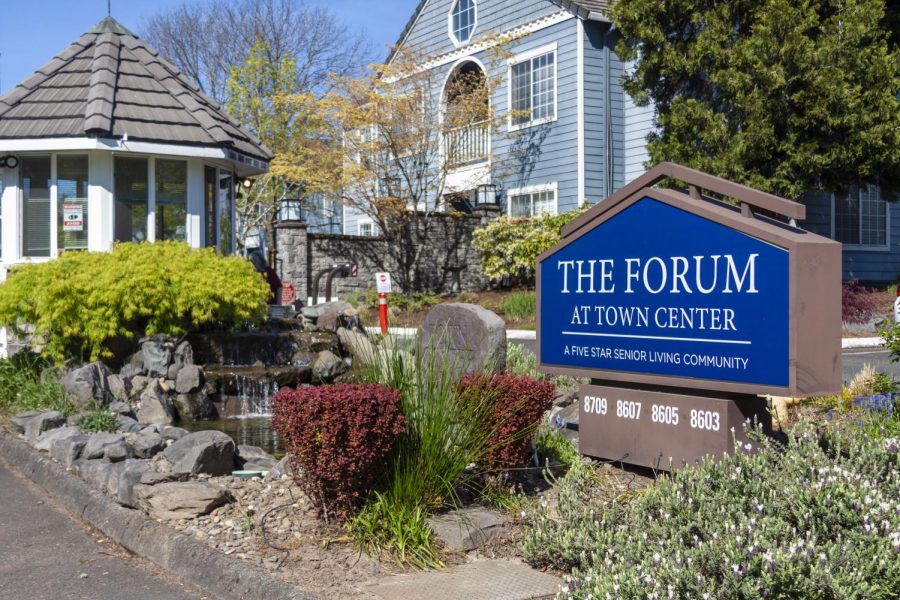What It’s Like Being an Essential Worker During the Coronavirus Pandemic
With the outbreak of COVID-19, everything I’ve become accustomed to over the course of this last year has changed drastically.
April 15, 2020
On Monday, March 23, when Governor Kate Brown issued the ‘stay at home’ order, my initial concern was the amount of time we would be away from school. What I didn’t think about was how this might affect my part-time job as a server at a retirement home, where I’m considered an essential worker.
Despite the outbreak of the novel coronavirus surging across the globe, residents living in the assisted care facility that I work at still need to be fed and taken care of.
Flashing back to just less than a year ago, I applied for a server position at The Forum at Town Center after my older brother convinced me to work with him. My job consisted of taking residents’ meal orders, serving food and drinks, and dining room and kitchen cleanup. Recently, however, with the outbreak of COVID-19, everything I’ve become accustomed to over the course of this last year has changed drastically.
When we were still learning on campus, I would usually work four to five days a week, covering the dinner shift from 4:00 p.m. to 7:30 p.m., which wasn’t very strenuous. Since I now have the ability to complete my schoolwork on my own schedule, I have started working the 6:30 a.m. to 2:00 p.m. shift on the weekends and some weekdays. Sometimes I am scheduled to work, but other times I pick up these additional shifts because the morning crew is often understaffed, and I know they could use extra help.
My workplace has taken serious precautions in an attempt to stop the virus from making its way into one of the buildings.
The dining room is closed and all residents are mostly confined to their rooms during meals, or must sit at least six feet apart in common areas on the second floor. Throughout the day, residents may leave their rooms to go outside or open spaces, but must keep distance from one another.
When I got to work, I used to go straight to the break room, clock-in, and head to the kitchen. Now, before my shift begins, I must fill out a questionnaire, get my temperature taken, thoroughly wash my hands, and put on masks and gloves.
The kitchen staff no longer interacts with the residents, but instead places their meals on a shelf outside their doors, where the food waits to be brought in by caregivers.
Not only have we changed the way meals are served, but the hours that employees are working are changing. With school online for the rest of the academic year, many employees like me have more free time, which can be spent working.
In addition, many of the seasonal workers have returned from college as a result of this pandemic, so it might seem that schedules would become more lenient; however, many employees are also being pulled off the schedule if they’ve been in close contact with someone showing symptoms of COVID-19.
Working during these unprecedented times is stressful, to say the least. While the coronavirus continues to affect more and more people, the elderly and those who have underlying health conditions are at the highest risk. Every day, I have to be very conscious of what I do, who I see, and what I touch.
If the coronavirus were to spread through my workplace, it would most likely be catastrophic, putting all residents at serious risk. I am constantly living in fear that I will be the one who brings the virus to anyone at the retirement home.
For me, being an essential worker during this pandemic is not a fun experience, but I am not working because I want to or feel safe. I work because I have to: The residents that I am serving still need to have access to everything they need to survive.
While I may be worried about going to work and bringing COVID-19 to the residents, I am fortunate to be working and receiving a paycheck, especially since more than 17 million Americans have lost their jobs and filed for unemployment.
The entirety of this coronavirus pandemic is terrifying and stressful, but I urge everyone who has the ability to stay home to do so. I continue to see people not take the stay at home order seriously and post on social media with their friends. If more people were social distancing, the chances of the virus appearing in my workplace would be slimmer. COVID-19 is real and alarming, so let’s do everything we can to help save lives and flatten the curve.





